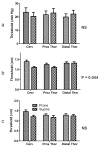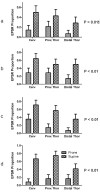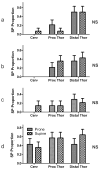The effect of body position on esophageal reflexes in cats: a possible mechanism of SIDS?
- PMID: 29166377
- PMCID: PMC5902647
- DOI: 10.1038/pr.2017.302
The effect of body position on esophageal reflexes in cats: a possible mechanism of SIDS?
Abstract
BackgroundIt has been hypothesized that life-threatening events are caused by supraesophageal reflux (SER) of gastric contents that activates laryngeal chemoreflex-stimulated apnea. Placing infants supine decreases the risk of sudden infant death syndrome (SIDS). The aim of this study was to determine whether body position affects esophageal reflexes that control SER.MethodsWe instrumented the pharyngeal and esophageal muscles of decerebrate cats (N=14) to record EMG or manometry, and investigated the effects of body position on the esophago-upper esophageal sphincter (UES) contractile reflex (EUCR), esophago-UES relaxation reflex (EURR), esophagus-stimulated pharyngeal swallow response (EPSR), secondary peristalsis (SP), and pharyngeal swallow (PS). EPSR, EUCR, and SP were activated by balloon distension, EURR by air pulse, and PS by nasopharyngeal water injection. The esophagus was stimulated in the cervical, proximal thoracic, and distal thoracic regions. The threshold stimulus for activation of EUCR, EURR, and PS, and the chance of activation of EPSR and SP were quantified.ResultsWe found that only EPSR was significantly more sensitive in the supine vs. prone position regardless of the stimulus or the position of the stimulus in the esophagus.ConclusionWe hypothesize that the EPSR may contribute to the protection of infants from SIDS by placement in the supine position.
Conflict of interest statement
Figures






Similar articles
-
Effects of esophageal acidification on esophageal reflexes controlling the upper esophageal sphincter.Am J Physiol Gastrointest Liver Physiol. 2019 Jan 1;316(1):G45-G54. doi: 10.1152/ajpgi.00292.2018. Epub 2018 Oct 11. Am J Physiol Gastrointest Liver Physiol. 2019. PMID: 30308131 Free PMC article.
-
Mechanisms of reflexes induced by esophageal distension.Am J Physiol Gastrointest Liver Physiol. 2001 Nov;281(5):G1246-63. doi: 10.1152/ajpgi.2001.281.5.G1246. Am J Physiol Gastrointest Liver Physiol. 2001. PMID: 11668034
-
The role of the superior laryngeal nerve in esophageal reflexes.Am J Physiol Gastrointest Liver Physiol. 2012 Jun 15;302(12):G1445-57. doi: 10.1152/ajpgi.00007.2012. Epub 2012 Mar 8. Am J Physiol Gastrointest Liver Physiol. 2012. PMID: 22403790 Free PMC article.
-
Reflex-mediated enhancement of airway protective mechanisms.Am J Med. 2000 Mar 6;108 Suppl 4a:8S-14S. doi: 10.1016/s0002-9343(99)00289-2. Am J Med. 2000. PMID: 10718445 Review.
-
Development of pharyngo-esophageal physiology during swallowing in the preterm infant.Neurogastroenterol Motil. 2011 Oct;23(10):e401-8. doi: 10.1111/j.1365-2982.2011.01763.x. Epub 2011 Aug 9. Neurogastroenterol Motil. 2011. PMID: 21827583 Review.
Cited by
-
Mechanisms of Aerodigestive Symptoms in Infants with Varying Acid Reflux Index Determined by Esophageal Manometry.J Pediatr. 2019 Mar;206:240-247. doi: 10.1016/j.jpeds.2018.10.051. Epub 2018 Nov 19. J Pediatr. 2019. PMID: 30466790 Free PMC article.
-
Effects of esophageal acidification on esophageal reflexes controlling the upper esophageal sphincter.Am J Physiol Gastrointest Liver Physiol. 2019 Jan 1;316(1):G45-G54. doi: 10.1152/ajpgi.00292.2018. Epub 2018 Oct 11. Am J Physiol Gastrointest Liver Physiol. 2019. PMID: 30308131 Free PMC article.
-
The enigma of gastroesophageal reflux disease among convalescing infants in the NICU: It is time to rethink.Int J Pediatr Adolesc Med. 2020 Mar;7(1):26-30. doi: 10.1016/j.ijpam.2020.03.001. Epub 2020 Mar 5. Int J Pediatr Adolesc Med. 2020. PMID: 32373699 Free PMC article.
-
Pharyngoesophageal and cardiorespiratory interactions: potential implications for premature infants at risk of clinically significant cardiorespiratory events.Am J Physiol Gastrointest Liver Physiol. 2019 Feb 1;316(2):G304-G312. doi: 10.1152/ajpgi.00303.2018. Epub 2018 Dec 13. Am J Physiol Gastrointest Liver Physiol. 2019. PMID: 30543445 Free PMC article.
-
Rapid activation of esophageal mechanoreceptors alters the pharyngeal phase of swallow: Evidence for inspiratory activity during swallow.PLoS One. 2021 Apr 2;16(4):e0248994. doi: 10.1371/journal.pone.0248994. eCollection 2021. PLoS One. 2021. PMID: 33798212 Free PMC article.
References
-
- Dwyer T, Ponsonby AL. Sudden infant death syndrome and prone sleeping position. Annals of Epidemiology. 2009;19:245–249. - PubMed
-
- Gilbert R, Salanti G, Harden M, See S. Infant sleeping position and the sudden infant death syndrome: systematic review of observational studies and historical review of recommendations from 1940 to 2002. International Journal of Epidemiology. 2005;34:874–887. - PubMed
-
- Jeffrey HE, Megevand A, Page M. Why the prone position is a risk factor for sudden infant death syndrome. Pediatrics. 1999;104:263–269. - PubMed
-
- Jeffrey HE, Page M, Post EJ, Wood AKW. Physiological studies of gastro-oesophageal reflux and airway protective response in the young animals and human infant. Clin Exp Pharmacol Physiol. 1995;22:544–549. - PubMed
-
- Leiter JC, Bohm I. Mechanisms of pathogenesis in the sudden infant death syndrome. Resp Physiol Neurobiol. 2007;159:127–138. - PubMed
Publication types
MeSH terms
Grants and funding
LinkOut - more resources
Full Text Sources
Other Literature Sources
Medical
Miscellaneous

